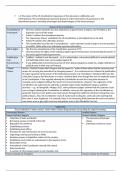Other
US Politics Notes
- Module
- US Government & Politics
- Institution
- PEARSON (PEARSON)
A comprehensive list of all the revision notes you need to revise US Politics for your Edexcel A-Level Government & Politics exam. Contains notes about: the constitution - key features & amendment process etc.; the structure and functions of Congress; interpretation and debates around Congress; sou...
[Show more]












